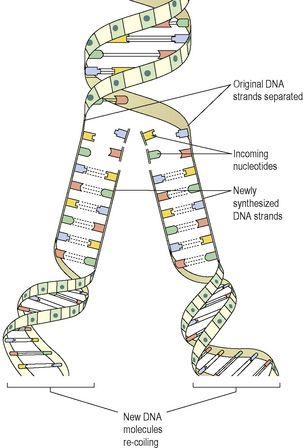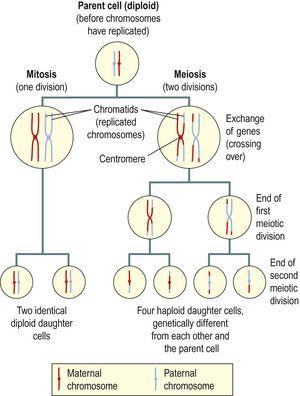Ross & Wilson Anatomy and Physiology in Health and Illness (200 page)
Read Ross & Wilson Anatomy and Physiology in Health and Illness Online
Authors: Anne Waugh,Allison Grant
Tags: #Medical, #Nursing, #General, #Anatomy

Figure 17.7
DNA replication.
Mitosis
This is described on
page 31
.
Meiosis
Meiosis produces gametes. On fertilisation, when the male gamete (sperm cell) and the female gamete (ovum) unite, the resulting
zygote
is diploid, because each gamete was haploid.
Unlike mitosis, meiosis involves two distinct cell divisions rather than one (
Fig. 17.8
). Additionally, meiosis produces four daughter cells, not two, all different from the parent cells and from each other. This is the basis of genetic diversity and the uniqueness of each human individual.
Figure 17.8
Mitosis and meiosis, showing only one pair of chromosomes for clarity.
First meiotic division
This stage (
Fig. 17.8
) produces two genetically different daughter cells.
DNA replication occurred beforehand, so each pair of chromosomes is now four chromatids, and they gather together into a tight bundle. Because the chromosomes are so tightly associated, it is possible for them to exchange genes. This process is called
crossing over , and results in the four chromatids acquiring different combinations of genes. Following crossing over, the pairs of chromosomes then separate in preparation for the first meiotic division, and transfer of maternal and paternal chromosomes to either daughter cell is random. This means that the two daughter cells have an unpredictable assortment of maternal and paternal DNA, giving rise to a huge number of possible combinations of chromosomes in them. This explains why a child inherits a combination of its mother’s and father’s characteristics.
, and results in the four chromatids acquiring different combinations of genes. Following crossing over, the pairs of chromosomes then separate in preparation for the first meiotic division, and transfer of maternal and paternal chromosomes to either daughter cell is random. This means that the two daughter cells have an unpredictable assortment of maternal and paternal DNA, giving rise to a huge number of possible combinations of chromosomes in them. This explains why a child inherits a combination of its mother’s and father’s characteristics.
Each pair of chromosomes separates and one travels to each end of the cell, guided by a spindle as in mitosis, and the cytoplasm divides, producing two genetically unique diploid daughter cells.
Second meiotic division
For a gamete to be produced, the amount of genetic material present in the two daughter cells following the first meiotic division must be halved. This is accomplished by a second division (
Fig. 17.8
). The centromeres separate and the two sister chromatids travel to opposite ends of the cell, which then divides. Each of the four haploid daughter cells now has only one chromosome from each original pair. Fusion with another gamete creates a zygote (fertilised ovum), a diploid cell which can then go on to grow and develop into a human being by mitosis.
The genetic basis of inheritance
Learning outcomes
After studying this section, you should be able to:
describe the basis of autosomal inheritance, including the relevance of recessive and dominant genes
explain how sex-linked characteristics are passed from one generation to the next.
Mixing up of parental genes during meiosis leads to the huge genetic variety of the human race. It is important to understand how genes interact to produce inherited characteristics.
Autosomal inheritance
Each of a pair of homologous chromosomes contains genes for the same traits. For example, the ability to roll one’s tongue is coded for on a single gene. Because one chromosome of each pair is inherited from the father and one from the mother, an individual has two genes controlling the ability to roll the tongue. Such paired genes are called
alleles
. Corresponding alleles contain genes concerned with the same trait, but they need not be identical. An individual may have:
•
two identical forms of the gene (
homozygous
)
•
two different forms of the gene (
heterozygous
).
One copy of the tongue-rolling gene may code for the ability to roll the tongue, but the corresponding gene on the other chromosome of the pair may be a different form and code for inability to tongue roll. This example involves only two forms of the same gene, but other characteristics are more complex. Eye colour is a diverse trait with a wide range of pigment colours and patterns possible, and is controlled by more than one gene.
Should an individual inherit a tongue-rolling gene from one parent, and the non-rolling gene from the other, he will be able to roll his tongue. This is because the tongue-rolling form of the gene is
dominant
, and takes priority over the non-rolling gene, which is recessive. Dominant genes are always
expressed
(active) in preference over recessive genes, and only one copy of a dominant gene is required for that characteristic to be expressed. A recessive gene can only be expressed if it is present on both chromosomes, i.e. individuals unable to tongue-roll have two copies of the recessive, non-rolling gene.
Individuals homozygous for a gene have two identical copies, of either the dominant or the recessive form. Heterozygous individuals have one dominant and one recessive gene.
Punnett squares
The probability of inheriting either form of a gene depends upon parental make-up. Simple autosomal inheritance can be illustrated using a Punnett square.
Figure 17.9
shows all the possible combinations of the tongue-rolling gene in children whose parents are heterozygous for the trait. Using this example, there is a 3 in 4 (75%) chance that the child of these parents will be a tongue roller (TT or Tt), and only a 1 in 4 chance that they would inherit two recessive genes (tt), making them a non-roller.



